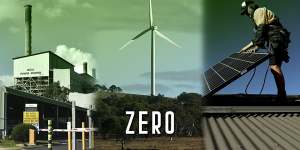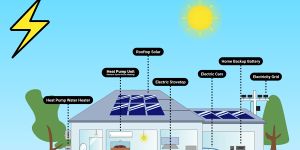But with the right investments,Perth is on the cusp of being a city where energy is plentiful,secure,affordable,and zero emissions.

The technology is here already – but the investment isn’t.Graphic:Kathleen Adele
The technology building blocks to realise this future are already available. The challenge lies in finding the imagination and political will to implement the reforms needed to unlock public and private investments needed in renewable energy,storage,transmission and enabling infrastructure.
We represent Sustainable Energy Now,a not-for-profit advocacy group with more than 90 volunteer members from a range of professions – engineering,scientific and legal,among others.
We have seen a dramatic 90 per cent fall in the cost of rooftop photovoltaic panels over the last decade that has allowed many households in Perth with solar to enjoy the lowest cost of electricity in the OECD. Almost a megawatt of solar is added each day to WA’s main grid,the South West electricity grid. That is an extraordinary 350 megawatts a year on our rooftops. And we’ve only used less than a third of potential roof space. Internationally,Australia is leading the charge on rooftop solar. WA recently set a new instantaneous renewables record of
81% in the world’s biggest isolated grid – during that week renewables supplied nearly 40 per cent
of total electricity generated in WA’s electricity market.
There is sufficient unused roof space in Perth to meet all our energy needs several times over using rooftop panels,with storage.
But a resilient electricity grid needs a diversity of energy sources. Investment is also needed in the other renewable source WA has in abundance – wind. Perth is a very windy city with near-constant year-round winds. WA needs to build around 4 gigawatts of additional wind capacity this decade to account for the phase-out of coal and accommodate modest growth in operational demand out to 2030. This includes more turbines in our windy Mid West,and offshore wind farms.
Investment in a significant amount of energy storage is also required to make the daily abundance of solar energy available for early evening and night-time use. Storage helps firm variable renewable energy,so it can be dispatched on demand.
Short-term energy storage will largely be a series of batteries across Perth capturing energy at a local,community and grid level. WA has one big battery nearing completion in Kwinana (200 megawatt hours) but it needs plenty more – modelling by Sustainable Energy Now indicates 12 gigawatt hours of storage is required. So we need the equivalent of 60 more of those Kwinana
batteries:across electric vehicle batteries,house batteries,community batteries as well as utility -scale big batteries like the Kwinana example and longer-duration energy storage technologies. Other states are investing heavily in storage and WA is lagging behind.
The part EVs could play? They have the potential to be grid-connected,allowing you to plug your car into the grid to charge from excess energy during the day,then draw energy from it at night. At night you could run your house from your car,because a car battery is five times larger than a house battery. The vehicle-to-grid technology for this already exists.

How your house would run in a net-zero Perth.Rewiring Australia
Long duration energy storage is required for when the sun doesn’t shine,or the wind doesn’t blow for extended periods. This turns out to be not that often,when onshore and offshore wind over a wide geographical area are added to the energy mix alongside solar and battery storage.
That could be supplied by pumped hydro – storing water in reservoirs to be pumped in and out when energy is needed – and one or more of the more promising currently emerging technologies such as compressed air energy storage. There are feasibility studies being run now to look at pumped hydro for the. Traditional gas turbine generation would be held in emergency reserve.
Our modelling at Sustainable Energy Now demonstrates that this vision of an almost 100 per cent renewable energy-powered Perth can be an affordable reality.
The energy future is electric – especially in our homes and businesses.
Home electrification using heat pumps for space heating and boosting solar hot water,induction cooktops and battery electric personal transport is the future of Net Zero Perth. This is achievable and practical now for most households given the right policies,incentives and regulations. Fully electrified homes are not only zero-emission but also save householders money – up to $5000 per annum by the end of the decade,as Rewiring Australia has demonstrated.
However,new business models are needed so that the availability and benefits of rooftop solar,electrification and batteries are available to everyone,not just the well-heeled owners of detached single dwellings.
Rented properties or apartments without direct access to rooftop solar would use affordable clean energy through “solar gardens” using virtual rooftop solar on other buildings (commercial,public buildings or industrial). Innovative business models would unlock this huge potential energy source allowing energy users to become “prosumers” who both produce and consume energy whilst being investors in those businesses that agglomerate rooftop solar and battery storage on behalf of shareholders.
Energy use would become much more visible,democratised and controllable by the end-user.
All energy users could participate in communities that would be both physical and virtual. Residents in social and community housing would share equally in the benefit of a clean energy future.
So,the clean energy future doesn’t require a silver bullet. Just the right policies,regulation and timely government investment to unlock the benefits of renewable energy for all West Australians.
WA’s electricity system was originally designed around central thermal power stations,largely coal and gas,and now needs a complete overhaul of its generation,storage,transmission and distribution networks to become a smart grid suitable for a clean renewable energy future.
All the modelling and transition analysis in this area shows this work is essential and needs to happen quickly.
Despite their current energy crisis and not because of it,the eastern states are well ahead of us and investment well beyond the should be a priority for the current state government,so that WA will not be left behind in a net-zero world.
Follow WAtoday on,, and for handpicked selections of the day’s biggest local,national and international news.